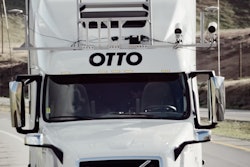
With over 30 million users a month in 425 cities in 72 countries, some would say that Uber is fast changing the face of global road transport. The start-up, which was founded by Travis Kalanick in 2010, has severely disrupted the taxi industry in many cities around the world (The Economist).
And now it seems, Kalanick, whose company is now worth a staggering $70 billion, has his eyes firmly fixed on unsettling the logistics sector by establishing a new business line, Uber Freight. In August 2016, Uber issued a statement of intent by purchasing Otto, an autonomous truck company for over $600 million. Recently, in an interview given to The Economist, Uber estimated that it could draw “20 percent of (its) future profits from trucking.”
So how exactly does Uber plan to turn the global freight business on its head? What are its aspirations? Details are sketchy and opaque at present. On contacting Uber’s media relations team, a spokesperson would only confirmed that it “didn’t have anything more to share on this [subject] at the moment,” but promised to reach out in the future when it did.
But while Uber’s communications team chooses to remain tight-lipped, Kalanick has been fairly bullish about his company’s ambitions. Uber is definitely “getting into the trucking business,” he told German-owned online newspaper, Business Insider late last year. Since giving the interview, according to Business Insider, Otto has begun advertising vacancies in both Illinois and California, which many recognize as the heartland of the U.S. logistics brokerage.
And Eric Berdinis, a senior product manager for Uber Freight, has gone even further. In October last year, he told Business Insider that Uber’s aim was not just to create, develop and engineer self-driving truck apps that freight operators could buy and use, but to “build a marketplace that would allow self-driving trucks to flourish.”
So, what will this new marketplace look like? More important, what are the unique selling points – the differentiators – that Uber believes sets it apart from traditional freight models?
At the heart of its offering, says Business Insider, is a leading-edge freight app, not too dissimilar from its ride-sharing platform, which Uber hopes will enable shippers to connect to trucks in real time, thus eliminating middlemen, such as brokers altogether.
But with brokers earning as much as 20 percent in commission, some say, in theory at least, that the new model that Uber is championing, in which the fee paid to Uber by the shippers is determined by supply and demand, could spell danger for the brokerage industry (Business Insider).
While only time will tell if Uber’s Freight offering is successful, it has a longer term vision in mind, seeing Uber Freight as a staging-post for mass autonomous truck take-up. As part of its blueprint, it plans to reach out to carriers and shippers with a symbiotic blueprint. In return for granting early adopters access to its technology platform, Uber hopes to benefit by collecting advanced driving data to feed its algorithms, which it sees as a stepping-stone to automation (Business Insider).
However, while Uber has made no secret of that fact that its ultimate goal is automated fleets, it stressed to Business Insider that “self-driving vehicles won’t be substitutes for human drivers in all situations.”
But, for many in the industry, Uber’s masterplan raises some fundamental questions.
Namely, can Uber, with its fledging autonomous freight business, really compete with established freight, haulage and logistics operators? Many have not only spent decades perfecting their service offering, but also have grown stronger by entering into collaborative alliances where information sharing is actively encouraged.
Many startups seeking to build trucking services have already tried and failed. Take Cargomatic, for example. In 2013, the California startup began to develop a real-time app, linking shippers to truckers and, more important, the available space in their trucks. While in theory the app made sense, in reality, according to Business Insider, only around 10 percent of the company’s business was generated through the platform. Perhaps, most tellingly, was Business Insider’s observation that the Cargomatic’s USP – the flow of real-time data between trucker, load and shipper – did not actually exist. Instead, information was being inputted manually and there was no real-time integration.
Five other match-loading startups, Convoy and CargoX, Transfix, CargoChief and TruckerPath are still attempting to blaze a trail, but Jonathan Wichmann, who worked as a consultant for Maersk for two years, says that the jury is still out as to whether startups can truly disrupt traditional markets.
In an article written by Peter Tirschwell, a senior director of content within the IHS Maritime and Trade Group, Wichmann said that “the logistics business is not easy on the startups. There’s a reluctance among the big players to change their business models.”
But, it is a view that Evan Armstrong, the president of global third-party supply chain market research firm Armstrong & Associates, Inc., only partially agrees with.
There is very little that Armstrong does not know about transport, third-party logistics services and trailblazing startups seeking to corner the market for that matter.
In a recent conversation, Armstrong, whose market research firm recently produced a report titled “Digital Freight Matching – Capturing Technology-Based Efficiencies in the Trucking Industry,” related that “We carried out an in-depth analysis of the 27 digital freight matching companies that currently operate in this space. In short, our research revealed that while the startups were offering a high-degree of innovation, it still fell short of actually being able to solve many of the real-world challenges that the industry faces day-in and day-out.
“For example, while many of these apps are beneficial to the industry, in the way they harness real-time time data to accurately match a shipment to a carrier, or pinpoint truck stops; however, the transport sector is more complex than simple passenger ride-hailing. For example, there are different modes and equipment types, and no algorithm currently exists which neatly ties this industry together. If, for instance, you have a 2,000 kilo shipment destined for La Guardia Airport in New York, and the truck breaks down, the shipment cannot walk out of the truck and find another one. A reputable replacement carrier that can cover the load would need to be found quickly. At this point in time, human intervention is required to accomplish this exception handling.”
Armstrong continues, “So, it’s not that large third-party logistics providers such as C. H. Robinson and DB Schenker are not interested. They are. In June 2016, for instance, DB Schenker struck a deal with online freight platform, UShip Inc. to connect shippers with truckers online in Europe.”
However, Armstrong, who recently presented his findings at a roundtable logistics seminar at MIT,
doesn’t believe any of these startups, Uber included, will be successful in disrupting the highly organic and innovative model that already exists.
“When we read the headlines about Uber Freight, it is easy to forget that multi-billion dollar, third-party logistics providers such as C.H Robinson, Coyote, TQL, XPO Logistics, DHL Supply Chain, and DB Schenker are already very efficient at managing transportation for customers. They have more carrier capacity and network scale, which drive superior pricing and operational performance, making them more competitive than any startup. “
Armstrong also thinks that industry-leading load board operations, such as DAT and Internet TruckStop, which help match million loads to carriers via their powerful applications, and freight trading platforms, like the Transport Exchange Group, which helps its 4,500+ member companies to reduce dead mileage and empty legs through several innovative online exchanges, also could make it very difficult for companies like Uber to flourish in the future.
“They have already developed integrated desktop and mobile applications for matching loads to carriers. The real-time technology has been programmed to understand the ‘load-matching’ requirements of shippers, brokers and carriers who operate in this highly nuanced logistics landscape. In addition, they have information on carrier regulatory compliance as well. Therefore, the software carries real-time reviews of carriers’ capabilities and insurance details, plus real-time updates when the load has been dispatched. The large scale of this existing visibility and collaboration is very hard to beat.”
So, does Armstrong see a future for Uber Freight?
“I don’t believe it can flourish as a company championing one stand-alone app. If it wants to grow, it will have to adopt a flexible and collaborative approach to the wider industry. Second, it will need to recruit world-class management staff who understand every aspect of the industry. And third, Uber Freight must put in place a transportation management/freight brokerage operation to support its application and allow it to ‘work out’ any transportation exceptions which may happen en route.”
Armstrong goes on to say, “While I don’t see it as being a threat to established players. Armstrong & Associates estimates the U.S. domestic transportation management third-party logistics sector to be worth $60 billion and its overall market potential is an estimated $380 billion, so there’s space for everyone to grow.”
But for anyone still fearing for the future, perhaps Armstrong’s telling anecdote will help provide some reassurance and prevent any more sleepless nights.
Recounts Armstrong, “I recently participated in a roundtable discussion at MIT which was centered on how Digital Freight Matching startups like Uber Freight were impacting the industry. In the room were over 25 experts from 3PLs and large shippers. While there was some interest in next generation freight matching apps, the discussion of apps got overtaken by shippers discussing Electronic Data Interchange, which is a problem that even a flashy app can’t fix.”














